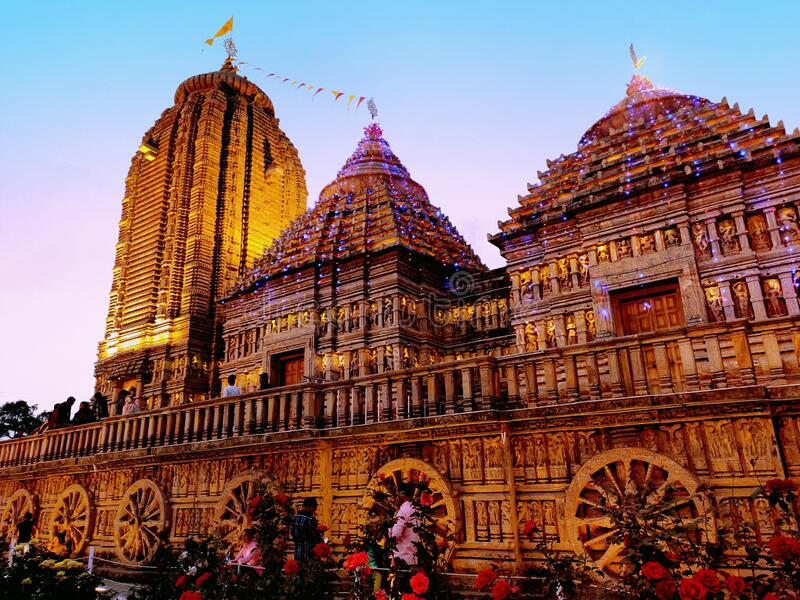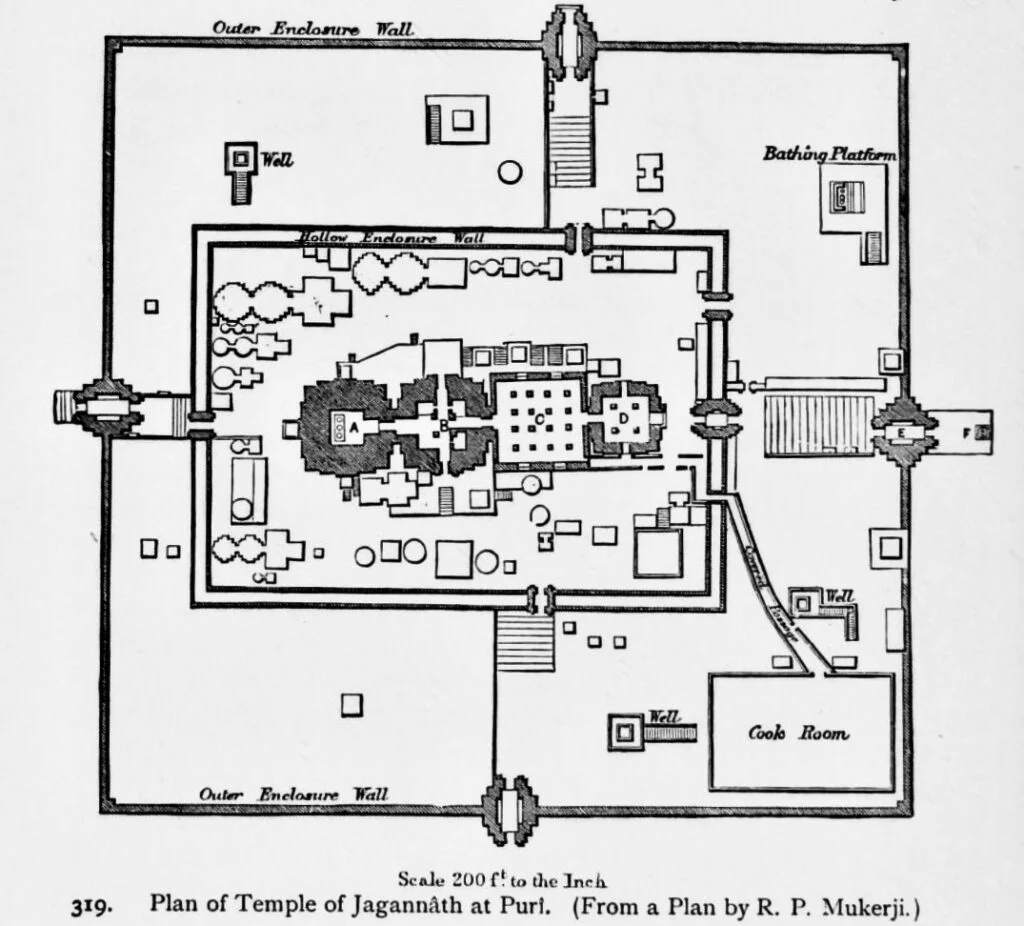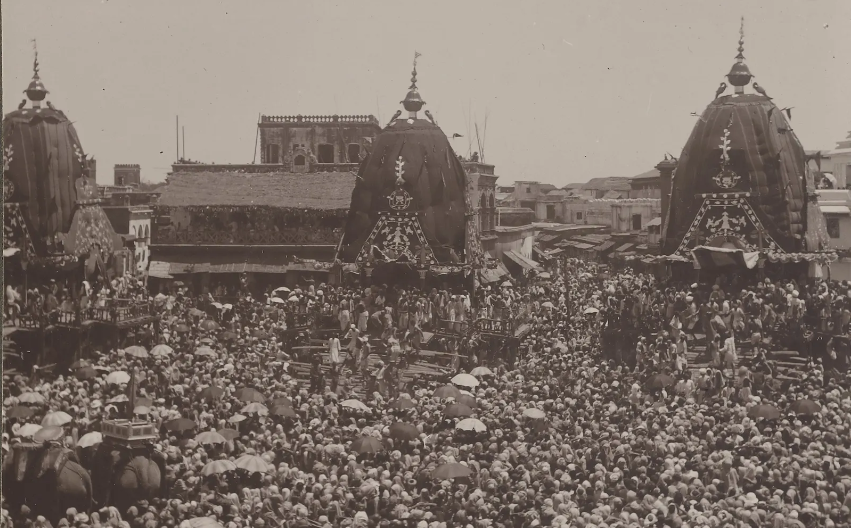Millions of devotees from across the world are thronged to see the famed Jagannath Temple and the Rath Yatra of the temple in the small town of Puri in Odisha each year.
The temple and the chariot of the Rath yatra are architectural marvels that reflect the beauty of Odisha’s traditional heritage and the devoted nature of the craftspersons that worked on it. The RathYatra is a colourful delight for all its visitors that happens according to the Hindu Calendar each year. In the chariot festival, the idol of Lord Jagannath is taken out from the sanctum and taken around in the state in a large beautifully carved wooden chariot made painstakingly by the craftspersons. In this article, we shall be delving into some details about the temple, its architecture, the RathYatra, learn about the architectural elements of the Chariot and the Jagannath Heritage Corridor that is to be inaugurated soon in the region.

Jagannath Temple in Puri and its Architectural Elements
The magnificent temple of Lord Jagannath was built during the rule of Anantavarman Chodaganga Deva of the Ganga dynasty in 12th century A.D. The temple building is a magnificent example of Kalinga-style architecture and is covered in gorgeous sculptures and excellent carvings.
Standing on a raised high platform, it has four components – the Vimana or Deula (Grabagriha), Jagmohana, Natamandapa and Bhogamandapa. There are two architectural styles employed in the temple – Rekha and Pidha, with the Vimana being built in Nagara style of Rekha deula and the Jagmohan is in Pidha deula. The Vimana or deula is built on a pancharatha ground plan, it begins in a vertical shape at the bottom up to the highest curvilinear shikhar. The construction is so distinctive that, irrespective of the sun’s orientation, the structure does not create a shadow on the ground.

What is the Rath Yatra?
The term Rath has been derived from Sanskrit and it means chariot or carriage while yatra means journey or pilgrimage, yatra is also referred to as Jatra in other languages.
The festival is believed to be one of the oldest public processions in the country that continues till date, which has been documented in our ancient sacred texts or Puranas. It celebrates Lord Jagannath, his elder brother Balabhadra and his younger sister Subadhra. These idols are taken to the Gundicha temple where the Gods and Goddesses reside for a while and are then taken back to their homestay (which is believed to be their aunt’s place). The return journey from Gundicha temple to the Jagannath temple is called Bahuda Yatra which takes place on the ninth day of the festival.
:max_bytes(150000):strip_icc():format(webp)/148618856-56a3bee13df78cf7727f00a4.jpg)
The Legends Associated with the Idols
These three idols that go on a journey in the chariot festival are carved out of wood, cloth and resin instead of any precious stone or metal. They have uneven heads and no arms which comes from the legend of the impatient king. There are different stories that go around this legend, one is about the King Indrayumna, he tried to steal the heart of Krishna which was placed in the Dwarka sea after his cremation and appeared to the local tribes of the region in the form of an idol. When the King came to claim the heart in the shape of an idol, the idol disappeared. The King then wanted to rid himself of the sins, in absolution he sanctified Krishna in another form. Another legend goes that Krishna’s brother and sister rushed to Dwarka carrying Krishna’s half cremated body, and King Indrayumna dreamt of Krishna’s body floating in the river as log. The King hence built the temple to commemorate the Lord and appointed Vishwakarma, God’s own architect to craft the idols. Vishwakarma agreed but on the condition that he would not be disturbed from his work until it had reached completion. However, Vishwakarma disappeared when the images were half finished (some believe that Queen Gundicha entered his pavilion to see the progress and in anger, Vishwakarma disappeared). Despite the unfinished nature of the idols, the King decided to build a structure for the Gods and Goddesses and placed them at the temple. Once the wooden idols are disintegrated, they are made with the same material and half-done manner and placed in the temple, this process is carried out every 12 years or so.
:max_bytes(150000):strip_icc():format(webp)/GettyImages-575459495-591c614c5f9b58f4c09140d3.jpg)
Architectural Elements of the Rath of Lord Jagannath
Each deity is carried in an individual separate chariot, the Nandighosa, which is the chariot of Lord Jagannath is 45ft tall, and has 16 wheels, while the charioteer is called Daruka.
Lord Balabhadra is carried in Taladhwaja which has 14 wheels and the charioteer is called Matali. Lastly, Devi Subhadra is carried in Debadalana which has 12 wheels and charioteer is Arjuna.
:max_bytes(150000):strip_icc()/3642687233_fa441714a5_o-1--591c5f505f9b58f4c090ea7c.jpg)
The beautifully carved chariot in which the idols of Lord Jagannath and others are carried takes about 58 days to make by over 200 carpenters, painters, wood carvers, and other craftspersons. The art of making these chariots has been passed down in generations to these artisans who work with utmost precision and devotion to complete this masterpiece each year. The wood used in the Rath is provided for free of cost from the Odisha State Government with over 4000 pieces of wood is approximately required to complete the chariot. The shape of the chariot resembles that of a temple which follows the traditional format of Odisha temple making. Before the artisans start to work on the structure, a holy fire ritual is carried by the priests of the temple, the work begins with the making of the chariot wheels. It is believed that the large wheels are inspired by the big eyes of Lord Jagannath. A total of 42 wheels are carved by the craftspersons, and the canopies placed within the chariot are made in red, black, yellow and green colours. Neem wood is used to carved the idols that are placed within the chariot, as it is an auspicious element that should be used to make idols of Lord Vishnu.
The Fate of the Chariots Post the Festival
The chariots are dismantled post the journey and the wood is then reused and utilised in the temple kitchen for generating fuel which is believed to be the largest temple kitchen in the world. The kitchen makes over 56 eatables in a day and feeds anywhere between 2000 to 200000 people.

Jagannath Heritage Corridor Project
The Jagannath Temple, a living breathing sanctuary for its devotees in Odisha will soon have a pilgrim centre within the 75 metre corridor. The perimeter of the iconic Jagannath temple has been beautified and a significant amount has been spent on the same. It is called the Jagannath Heritage Corridor Project and is believed to be inaugurated on 17th January 2023. The foundation stone of the project was laid by the Chief Minister of the state in November of 2021. Among this project is the ‘Shree Setu’ a 2.8 kilometre bridge which will lead people coming in from Bhubaneshwar and Brahmagiri directly to the Jagannath Vallabh Parking lot near the temple.

Beyond the architectural splendour, the temple becomes a space where spirituality merges with the living fabric of the traditional culture of the region. The Rathyatra not only commemorates the divine journey of the Gods and Goddesses but reflects the timeless connection between the divine and the devoted.
References
- www.livemint.com/news/india/jagannath-puri-rath-yatra-history-significance-and-timing-all-you-need-to-know-11687227486202.html
- www.bbc.com/news/world-asia-india-48864239
- theanamikapandey.com/ratha-yatra-and-its-architecture/
- www.financialexpress.com/business/infrastructure-transforming-puri-2-8-kilometre-shree-setu-ac-tunnels-for-jagannath-temple-devotees-odisha-govt-implements-several-infrastructure-projectsnbsp-3358979/
10 Famous Artists Who Worked for Gita Press and Leela Chitra Mandir





